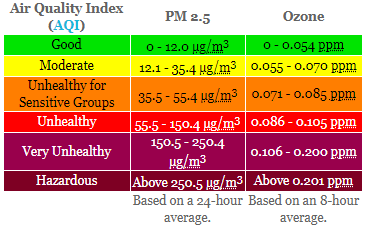
Warmer temperatures are here, and that means the Utah Department of Environmental Quality is checking ozone conditions. Although the Division of Air Quality (DAQ) monitors for ozone year-round, levels are most notable during the summer when emissions from vehicles and other sources combine with sunlight and heat. The highest ground-level ozone concentrations usually occur between noon and 8 p.m. from May through September.
DAQ provides Utah residents with air-quality forecasting throughout the summer through its UtahAir app (available for free download in both the Apple and Android apps stores), website, and regular email updates.
New this year: DEQ will post weekly video forecasts on Twitter @utahdeq. Follow us and use #UtahAQUpdate.
Air Quality Alert System
DAQ’s air quality alert system consists of two parts:
1. Action Alerts
Three basic symbols indicate unrestricted, voluntary and mandatory actions for ozone pollution.

Unrestricted Action No restrictions, but individuals are encouraged to limit emissions and choose cleaner transportation options.

Voluntary Action Individuals are asked to voluntarily TravelWise by consolidating trips and choose cleaner transportation options. Limit volatile organic compound emissions (VOC) emissions that commonly come from paints and solvents.

Mandatory Action Employers activate mandatory trip reduction programs. Individuals should TravelWise by consolidating trips and choose cleaner transportation options. Avoid gas-powered mowers, particularly during the hottest part of the day. Keep gasoline in airtight containers to avoid vapors and using high VOC products like paints and solvents. Limit volatile organic compound (VOC) emissions.
2. Health Guidance

EPA’s national standard Air Quality Index (AQI), which is divided into six, color-coded categories that correspond to different levels of pollution and related guidance for individuals with health concerns.
The months of May through September, when temperatures are high and daylight hours are long, are generally when the recipe of hot temperatures mixed with vehicle and industrial emissions can pose health risks for residents. Ground-level ozone, sometimes referred to as smog, can lead to shortness of breath, chest pains, and lung inflammation. It is encouraged to avoid exercise outdoors during the day when ozone is unhealthy for sensitive groups.
DAQ encourages Utah residents to visit Utah Clean Air Partnership (UCAIR) for more tips and ideas on how to reduce emissions, and to TravelWise during the summer months. For more information on ozone, check out DAQ Air Monitoring Section Manager Bo Call’s recent blog about understanding Utah’s air quality

